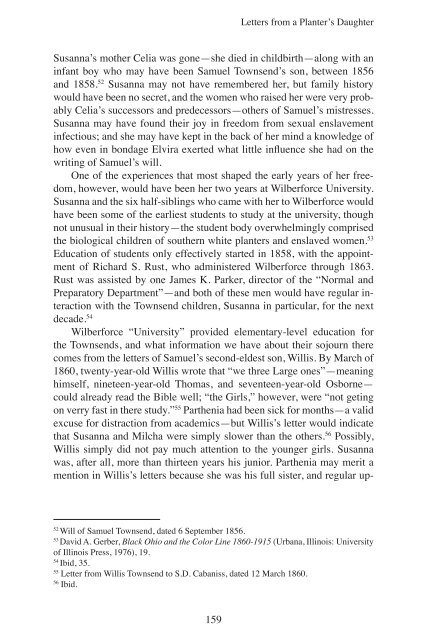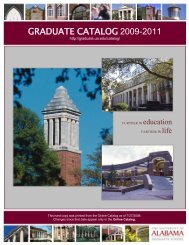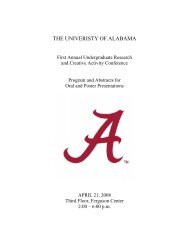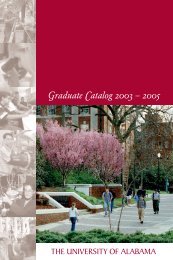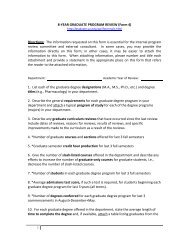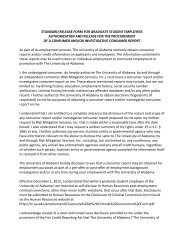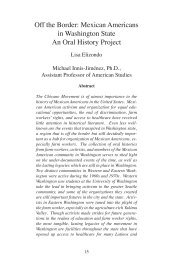Letters from a Planter's Daughter: Understanding Freedom and ...
Letters from a Planter's Daughter: Understanding Freedom and ...
Letters from a Planter's Daughter: Understanding Freedom and ...
You also want an ePaper? Increase the reach of your titles
YUMPU automatically turns print PDFs into web optimized ePapers that Google loves.
Susanna’s mother Celia was gone—she died in childbirth—along with an<br />
infant boy who may have been Samuel Townsend’s son, between 1856<br />
<strong>and</strong> 1858. 52 Susanna may not have remembered her, but family history<br />
would have been no secret, <strong>and</strong> the women who raised her were very probably<br />
Celia’s successors <strong>and</strong> predecessors—others of Samuel’s mistresses.<br />
Susanna may have found their joy in freedom <strong>from</strong> sexual enslavement<br />
infectious; <strong>and</strong> she may have kept in the back of her mind a knowledge of<br />
how even in bondage Elvira exerted what little influence she had on the<br />
writing of Samuel’s will.<br />
One of the experiences that most shaped the early years of her freedom,<br />
however, would have been her two years at Wilberforce University.<br />
Susanna <strong>and</strong> the six half-siblings who came with her to Wilberforce would<br />
have been some of the earliest students to study at the university, though<br />
not unusual in their history—the student body overwhelmingly comprised<br />
the biological children of southern white planters <strong>and</strong> enslaved women. 53<br />
Education of students only effectively started in 1858, with the appointment<br />
of Richard S. Rust, who administered Wilberforce through 1863.<br />
Rust was assisted by one James K. Parker, director of the “Normal <strong>and</strong><br />
Preparatory Department”—<strong>and</strong> both of these men would have regular interaction<br />
with the Townsend children, Susanna in particular, for the next<br />
decade. 54<br />
Wilberforce “University” provided elementary-level education for<br />
the Townsends, <strong>and</strong> what information we have about their sojourn there<br />
comes <strong>from</strong> the letters of Samuel’s second-eldest son, Willis. By March of<br />
1860, twenty-year-old Willis wrote that “we three Large ones”—meaning<br />
himself, nineteen-year-old Thomas, <strong>and</strong> seventeen-year-old Osborne—<br />
could already read the Bible well; “the Girls,” however, were “not geting<br />
on verry fast in there study.” 55 Parthenia had been sick for months—a valid<br />
excuse for distraction <strong>from</strong> academics—but Willis’s letter would indicate<br />
that Susanna <strong>and</strong> Milcha were simply slower than the others. 56 Possibly,<br />
Willis simply did not pay much attention to the younger girls. Susanna<br />
was, after all, more than thirteen years his junior. Parthenia may merit a<br />
mention in Willis’s letters because she was his full sister, <strong>and</strong> regular up-<br />
52 Will of Samuel Townsend, dated 6 September 1856.<br />
53 David A. Gerber, Black Ohio <strong>and</strong> the Color Line 1860-1915 (Urbana, Illinois: University<br />
of Illinois Press, 1976), 19.<br />
54 Ibid, 35.<br />
55 Letter <strong>from</strong> Willis Townsend to S.D. Cabaniss, dated 12 March 1860.<br />
56 Ibid.<br />
159<br />
<strong>Letters</strong> <strong>from</strong> a Planter’s <strong>Daughter</strong>


